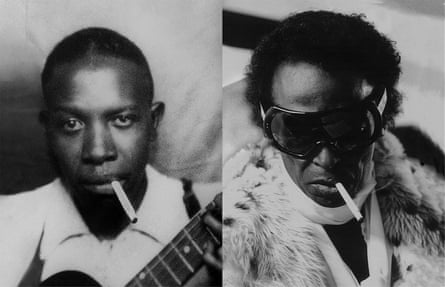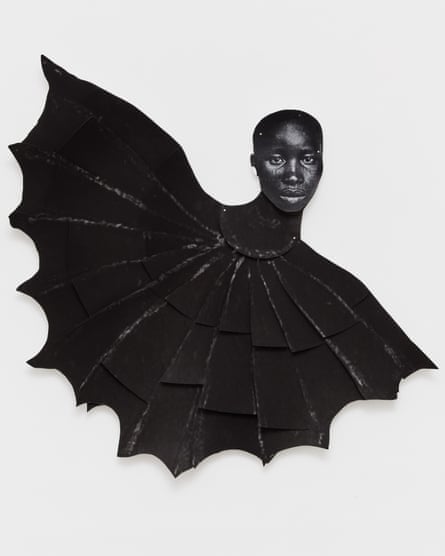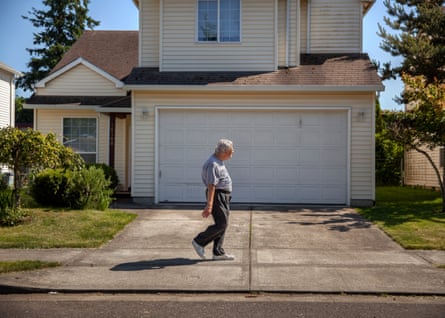[ad_1]
There are many abiding spirits, historical and cultural, hovering over the work on display on the fourth floor of the Photographers’ Gallery in London, where Samuel Fosso and Arthur Jafa are in competition for this year’s Deutsche Börse prize. As you enter the gallery, the stern faces of Martin Luther King, Haile Selassie and Angela Davis stare down from the opposite wall, instantly recognisable but unsettlingly unreal. Next door, Robert Johnson and Miles Davis gaze directly at the viewer, cigarettes dangling from their lips, the latter in particular seeming to channel the ghost of the mythical “bad man”, Stagger Lee, from behind his outsize shades.
Black history and identity loom large in the work of both artists, but also the historical and contemporary function of the photographic image in creating, and distorting, that history and identity. African Spirits, Fosso’s series of performative self-portraits of iconic black figures, have such a powerful presence that they seem to be watching you from across the years as you peruse his other work. The diptych on an adjoining wall in which Fosso pays homage to the many west African soldiers who fought in both world wars is poignant as well as historically and formally complex. It carries a less immediately dramatic, but no less resonant, charge.

In contrast, Jafa’s work resonates in a more visceral way, with found images from black history and contemporary culture coming together and colliding in an uneasy flow that echoes the dissonant urgency of certain strands of experimental jazz and futuristic funk. His epic show at Luma in Arles last year was titled Live Evil, a nod to Miles Davis’s 1971 album of the same name. The work on display here is a small, somewhat fragmented, distillation of that exhibition. Inevitably, the often wilfully jarring juxtapositions that comprise his exploration of every facet of black experience, from the joyous to the soul-numbingly repressive, lose some of their associative thrust in this much smaller setting. That said, the huge image of the site of a Rwandan massacre that takes up most of one wall is, if anything, more unsettling in this context, all the more so when contrasted with the adjacent blurred photo of HR, the lead singer of the hardcore punk band Bad Brains, suspended in mid air as if levitating. A taster, then, of Jafa’s ambitious and provocative practice, that leaves you longing for the full-scale experience.

Upstairs, sculptural photographic collages by the young Norwegian Nigerian artist Frida Orupabo make for the most intriguing display in the exhibition. Having followed her work with curiosity for some time on Instagram, where she posts as @nemiepeba, I was uncertain as to how her art would translate to the gallery. I needn’t have worried. Here, her strange, hybrid creations inhabit the space, seeming to hover on the walls as if about to become animated. Her raw material is sourced from the digital sphere – images found on social media, eBay and old colonial archives. Printed, cut out and then layered in segments, her collages have a distinctly old-fashioned, hands-on feel, but her mainly female figures are loaded with meaning, both personal and cultural.
There is something unsettling, too, in the looks on the faces she has retrieved from history, their direct, unsparing stares. “The stare back is a way of fighting objectification,” Orupabo states in an illuminating video about her work on YouTube, citing it as a kind of “resistance” to the gallery experience, one that hopefully precipitates an “internal dialogue” between the viewer and subject. Her quietly complex creations do that and much more. It is rare to see contemporary issues of identity, sexuality, race and belonging explored though work that is so singular, instinctive and elusive, so buoyed up by mysterious, unconscious undercurrents.
Entering the Belgian photographer Bieke Depoorter’s room, one is immediately transported to another conceptual universe, one of compulsion, self-doubt, blurred boundaries and ethical dilemmas. Her film, Michael, taken from A Chance Encounter, her exhibition in Berlin last year, tracks her relationship with one of her subjects, whom she met by accident in Portland in 2015, became close to, and then lost touch with when he mysteriously disappeared. Comprised of still images, Depoorter’s voiceover punctuated by the testimony of people who knew or crossed paths with Michael, the film has a cumulative power that has much to do with the hypnotic rhythm and grain of her narration as the unfolding images.

Michael remains an eccentric, if elusive, figure throughout, and there are moments when I began to wonder if he was a creation of the artist’s imagination: an accomplished actor in an elaborately constructed mystery. The room is covered with papers, photographs, notes and ephemera pertaining to Michael’s obsessive life and his disappearance, and the film, too, is haunted by his fleeting presence. Ultimately, though, it tells you more about the narrator than the subject, and, by extension, raises myriad questions about the compulsive nature of photography: the obsessive need to document, record, observe and track. A brave, self-interrogatory work, nevertheless, that stayed with me for hours afterwards in the manner of an intriguing short story. As to who might emerge as the winner: my heart is with Orupabo; my head says Jafa.
[ad_2]
READ SOURCE


